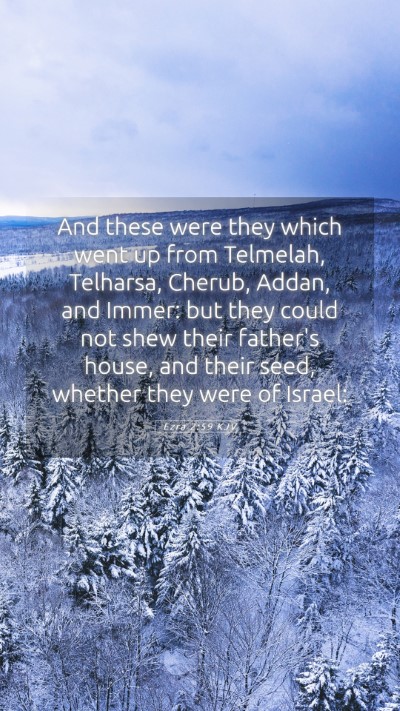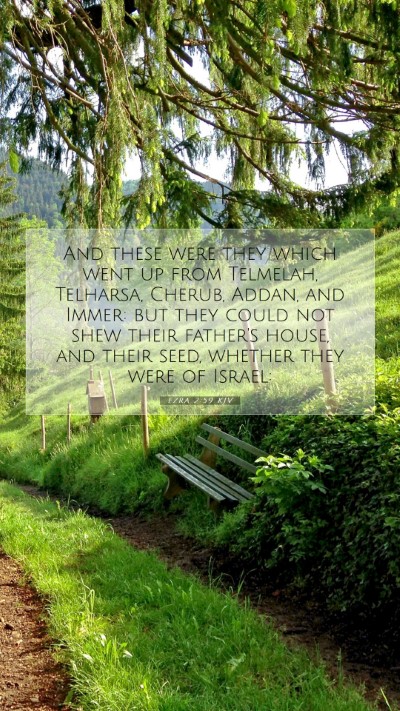Understanding Ezra 2:59
Ezra 2:59 is an intriguing verse in the Old Testament that lists a group of individuals, specifically those who were descendants of the priests, Levites, and the people returning from Babylonian exile. This verse provides a valuable context for understanding the community that was being restored post-exile. In examining this verse, we gain insights from respected public domain commentaries like those of Matthew Henry, Albert Barnes, and Adam Clarke. Below, we delve into a comprehensive understanding of this passage through the lens of these commentaries, also addressing the broader significance and implications for contemporary readers.
Context of Ezra 2:59
To interpret Ezra 2:59, we must first recognize the historical context of the Israelites returning from Babylon after years of exile. The book of Ezra focuses on the restoration of the Temple and the community, outlining the returns led by Zerubbabel and Jeshua. The details provided in Ezra 2 help categorize the groups, indicating a structured approach to reassembling the Jewish community in Jerusalem.
Verse Analysis and Commentary
-
Matthew Henry's Commentary:
Matthew Henry emphasizes the significance of lineage and the importance of returning to one’s roots. He notes that Ezra 2:59 specifically mentions those who could not prove their heritage, highlighting a theme of identity and belonging. For Henry, this verse underlines the seriousness of maintaining the purity of the priestly line, which was crucial in the religious restoration of Israel.
-
Albert Barnes' Notes:
Barnes provides an exposition on the genealogical records, suggesting that it was not only a census but also a necessary step to ensure the fulfillment of prophetic promises made regarding the Levitical priesthood. He points out how lack of proof could lead to certain individuals being disqualified from serving in temple duties. This adds layers to our understanding, indicating the meticulous care in reinstituting worship practices.
-
Adam Clarke's Commentary:
Clarke often looks at the implications on worship and governance. He comments on the emotional aspect of returning to a homeland and the challenges faced. The omission of names and the challenges of rekindling a lost connection through genealogy make the return from exile all the more poignant. Clarke underscores the perseverance of faith even when records are lost, reminding readers of the divine continuity in God's plan.
Key Themes in Ezra 2:59
-
Identity and Heritage:
The passage emphasizes the importance of knowing one’s heritage as the exiles returned. For readers today, this speaks to our own search for identity in the modern world.
-
Restoration:
Ezra 2:59 is a verse of restoration — physically speaking, in terms of returning to Jerusalem, and spiritually through reinstating the Temple worship.
-
Community and Belonging:
The gathering of people into their rightful roles stresses the importance of community ties in religious practice, thus underscoring the collective in individual faith journeys.
Application for Today
For contemporary readers, Ezra 2:59 may encourage exploration of personal and communal identity within the faith. Bible study groups can discuss how lineage affects identity today and contemplate the spiritual legacies passed down through generations. Furthermore, understanding Scripture through this verse can lead one to appreciate the historical and spiritual journey of the Israelites and apply those lessons in modern life.
Related Bible Cross References
- 1 Chronicles 9:1 - A focus on genealogies and the re-establishment of order post-exile.
- Nehemiah 7:61-64 - Further genealogical listings mirroring the concerns found in Ezra.
- Malachi 2:4-7 - Discusses the importance of the priesthood, echoing themes present in Ezra.
Conclusion
In summary, Ezra 2:59 serves as an entry point for deeper exploration into the themes of identity, community, and restoration within the Scripture. By utilizing Bible study tools and resources, individuals can enhance their understanding of such verses, not only through historical context but also through personal application. This interwoven approach to Scripture analysis leads to valuable insights, reinforcing the profound narratives within the Bible.


